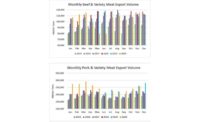USMEF reports record exports for all species

According to year-end statistics released by USDA and compiled by the U.S. Meat Export Federation, exports of U.S. pork, beef and lamb set new records across the board in 2011, reaching all-time highs in both volume and value and exceeding $11.5 billion in total value.
Pork exports totaled 2.255 million metric tons valued at $6.11 billion, breaking the previous volume record of 2.052 million metric tons and shattering the value record of $4.88 billion, which were both established in 2008. Year-over-year, pork exports were up 18 percent in volume and 28 percent in value.
Beef exports finished the year at 1.287 million metric tons valued at $5.42 billion. This broke the 2003 volume record of 1.274 million metric tons and easily surpassed the 2010 value record of $4.08 billion. Export volume was 21 percent larger than in 2010, with value up 33 percent.
Lamb exports totaled 18,343 metric tons valued at $30.08 million. This topped the previous record performance of 2006, when exports totaled 13,934 metric tons valued at $27.8 million. Compared to 2010, lamb export volume was up 72 percent and value increased 46 percent.
“It is extremely gratifying to see all red meat exports reaching new heights, even with the various trade obstacles we still face across the world,” said USMEF President and CEO Philip Seng. “U.S. producers have provided superior products to market and made solid investments in the international markets – not only from pork, beef and lamb checkoff programs, but also from the corn and soybean checkoffs. Along with the experienced staff we have in place in the foreign markets, our trade officials who continue to work for greater market access and the exporters and traders who work every day to grow the presence of U.S. meat worldwide, they are to be commended for their foresight and commitment to global marketing.”
While the record-breaking performance of 2011 is impressive, Seng feels strongly that USMEF and its industry partners have laid the groundwork for even greater success in the future.
“Demand for U.S. red meat has never been stronger, and we are well-positioned to build on this success,” he said. “We have the marketing tools in place to showcase the quality and consistency of U.S. products, which our industry is able to deliver at a very competitive price and end users are able to utilize in extremely creative and innovative ways. Real opportunities exist for further growth, and USMEF fully intends to capitalize on this strong momentum.”
For the year, pork exports equated to 27.5 percent of total production when including both muscle cuts and variety meat. In terms of muscle cuts only, exports totaled 23 percent of total production. This was up substantially from 23.7 percent and 19 percent, respectively, in 2010. Export value per head slaughtered was $55.55, an increase of 27 percent (nearly $12) from a year ago.
In December, pork exports were down slightly from November’s record performance but remained well above the previous year’s pace. Exports increased 16 percent in volume (215,870 metric tons) and 32 percent in value ($582.6 million) from December 2010.
“Among the factors driving the success of U.S. pork exports are the chilled programs and value-added programs that USMEF has implemented in several key markets, especially in north Asia,” Seng said. “Producers, processors and exporters have really worked together in recent years to provide a wider range of high-quality products that we can use to expand these markets. As a result of this collaboration, premiums delivered by the international markets continue to have a very positive impact on the U.S. pork industry’s growth and profitability.”
In addition to setting a global value record, Seng noted that the U.S. industry achieved new heights in its top two markets, Japan and Mexico.
“Coming off a record year in Japan, we grew export value by another 20 percent and nearly eclipsed the $2 billion mark,” he said. “That’s a testament to the effective marketing strategies deployed in what is easily the world’s most competitive pork market, as we have found new ways to further penetrate the restaurant and retail sectors and capitalize on rapidly growing sectors such as convenience stores. In Mexico, our outreach to national and regional supermarket chains has been highly successful, along with the strong relationships we have established in the processing sector.”
Pork exports to Japan set new records for both volume (493,313 metric tons) and value ($1.96 billion), respective increases of 13 percent and 19 percent over 2010. While slightly lower in volume (537,535 metric tons) than last year, Mexico became the first market other than Japan to import more than $1 billion in U.S. pork in a single year. Exports to Mexico jumped 6 percent in value over 2010, reaching $1.04 billion.
Other pork export highlights included several new records, with a very strong year in the Hong Kong/China region pushing exports up 64 percent in volume to 483,323 metric tons and nearly doubling in value to $910 million (and surpassed 2008 records). Exports to South Korea more than doubled in volume to 188,307 metric tons and increased 162 percent in value to $497 million. Exports to Australia grew 23 percent in volume (64,350 metric tons) and 38 percent in value ($204.6 million) – breaking the $200 million mark just seven years after the first exports of U.S. pork to this market. Central and South America saw increases of 21 percent in volume (72,023 metric tons) and 32 percent in value ($186.6 million), as existing free trade agreements with Honduras and Chile boosted 2011 exports and newly ratified trade agreements with Panama and Colombia offer excellent opportunities for further growth in 2012.
Beef export value per fed steer and heifer slaughtered was a record $206.37 in 2011, which was more than one-third higher than a year ago ($153.09). Beef exports equated to 14 percent of total production when including both muscle cuts and variety meat. For muscle cuts only, exports totaled 11 percent of total production. In 2010, these ratios were 11.7 percent and 9 percent, respectively.
“We have greatly diversified our beef export destinations and by doing so we have eclipsed the level of exports we had prior to BSE,” Seng said. “By building new markets and steadily reclaiming the market share we lost in Asia due to BSE, we were able to approach the $5.5 billion mark in 2011 – that’s one-third higher than the 2010 record, and a very significant achievement for the U.S. beef industry. This outstanding performance in the international markets is exactly the catalyst we need to grow our cattle numbers. Nothing helps grow operations like a boost in profitability, and the success we are achieving is definitely contributing to producers’ bottom line.”
In December, beef exports exceeded year-ago totals by about 6 percent in volume (108,691 metric tons) and 17 percent in value ($476.2 million) – posting the highest monthly volume total since September and the highest value total since August.
Canada was the leading value market for U.S. beef in 2011, reaching $1.03 billion – a 41 percent increase over 2010. Volume to Canada was up 25 percent to 191,047 metric tons. Mexico was the volume pacesetter at 256,938 metric tons (up 4 percent from 2010), with export value totaling $985.3 million (up 20 percent).
Exports to Japan surged 27 percent in volume (158,646 metric tons) and 37 percent in value ($874.4 million), while exports to Korea grew by 37 percent in volume (154,019 metric tons) and about one-third in value ($686 million), as the U.S. took significant market share from Australia.
“Programs such as ‘We Care’ in Japan and ‘To Trust’ in Korea have been very successful in rebuilding consumer confidence and positioning U.S. beef for success in these markets,” Seng said. “Safety continues to be a significant concern for our customers in both countries, but we are reaching a point at which we can focus more on the quality and enjoyment of the U.S. product. That is what made us the No. 1 supplier in these markets prior to 2003, and through effective marketing it will be the driving factor that allows us to reclaim that position.”
The newly ratified Korea-U.S. Free Trade Agreement offers excellent growth opportunities for both U.S. pork and beef, but U.S. exporters are especially anxious to gain relief from Korea’s 40 percent tariff on beef, which will be phased out over the next 15 years.
Other beef export highlights in 2011 include a record performance in the Middle East, where volume grew 30 percent to 175,181 metric tons and value was up 36 percent to $355.9 million. Russia also set new records for volume (72,797 metric tons, up 27 percent) and value ($255.9 million, up 68 percent), with a higher tariff rate quota for muscle cuts offering strong prospects for further growth in 2012. Last year’s quota was 41,700 metric tons, but Russia has increased it to 60,000 metric tons this year. U.S. beef is still not eligible for export to China, but new records were set in Hong Kong of 50,705 metric tons (up 28 percent) valued at $237 million (up 50 percent) and Vietnam $192 million (up 17 percent, though volume of 44,643 trailed the 2009 record). Led by a strong performance in Peru and Guatemala and exceptional growth in Chile, beef exports to Central and South America grew to record levels of 25,823 metric tons (up 53 percent) valued at $85.5 million (up 83 percent). U.S. beef will also be gaining significant tariff relief in Panama and Colombia this year as a result of the aforementioned trade agreements.
Through the first quarter of 2011, lamb exports were down about 10 percent in value from the previous year. Since that time, however, strong results in Mexico, Canada and the southeastern Caribbean pushed global export totals to a record performance. Other emerging markets showing promise for U.S lamb include Jordan, the United Arab Emirates, Panama and Costa Rica. In December, lamb exports exceeded year-ago totals by 14 percent in volume (1,385 metric tons) and 21 percent in value ($2.33 million), led by a strong performance in Mexico.
“While the industry is not large in size, U.S. lamb has tremendous potential internationally,” Seng said. “Chefs and other industry leaders around the world appreciate the quality of U.S. lamb and recognize it as a premium product, so we have some wonderful opportunities for growth.”
Source: USMEF
Looking for a reprint of this article?
From high-res PDFs to custom plaques, order your copy today!




